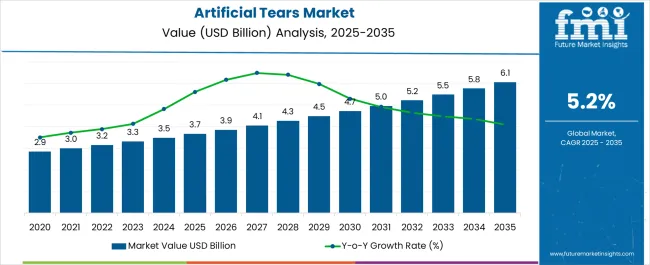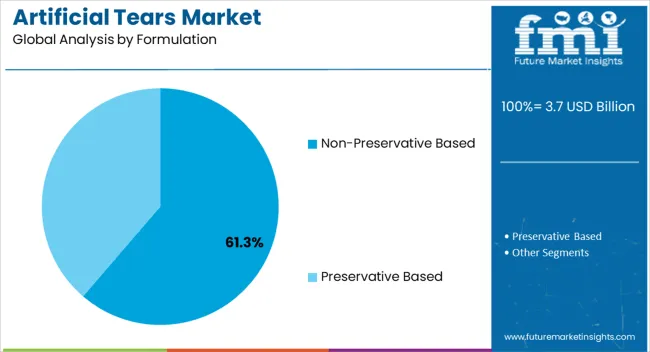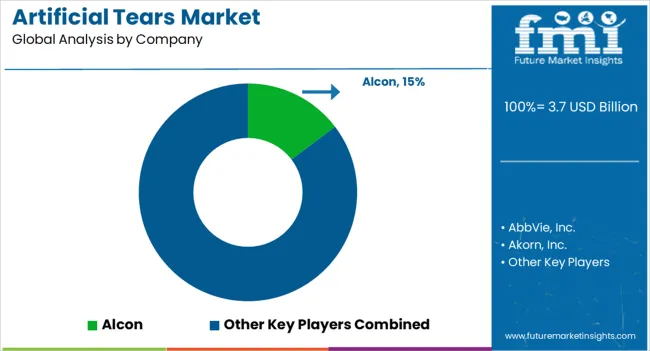The Artificial Tears Market is estimated to be valued at USD 3.7 billion in 2025 and is projected to reach USD 6.1 billion by 2035, registering a compound annual growth rate (CAGR) of 5.2% over the forecast period.

| Metric | Value |
|---|---|
| Artificial Tears Market Estimated Value in (2025 E) | USD 3.7 billion |
| Artificial Tears Market Forecast Value in (2035 F) | USD 6.1 billion |
| Forecast CAGR (2025 to 2035) | 5.2% |
The artificial tears market is experiencing robust growth due to rising prevalence of ocular disorders, increased screen time, and aging populations that drive demand for eye care products. Current dynamics are shaped by growing awareness of dry eye syndrome, advancements in ophthalmic formulations, and expansion of over-the-counter availability. Regulatory support for safe and effective ocular therapeutics and increasing healthcare accessibility are contributing to market penetration.
The future outlook is reinforced by innovations in preservative-free formulations, enhanced bioavailability, and multi-functional products that improve patient compliance. Growth rationale is grounded in sustained consumer preference for clinically validated, safe, and effective eye lubrication solutions.
Manufacturers are focusing on product differentiation, improved delivery systems, and distribution expansion across pharmacies, hospitals, and e-commerce platforms Collectively, these factors are expected to drive adoption across diverse demographic groups, ensuring consistent market expansion and competitive positioning over the forecast period.

The sodium hyaluronate based artificial tears segment, holding 28.40% of the product type category, has emerged as the leading choice due to its superior lubricating properties, high biocompatibility, and ability to retain moisture on the ocular surface. Its adoption has been strengthened by clinical validation demonstrating efficacy in relieving dry eye symptoms and enhancing patient comfort.
Production standards and regulatory compliance have reinforced trust among ophthalmologists and consumers. Technological improvements in molecular weight optimization and viscosity control have further enhanced performance.
Strategic initiatives by manufacturers, including targeted marketing and patient education programs, are supporting broader adoption The segment’s leadership is expected to be maintained through ongoing formulation innovation and growing awareness of its therapeutic benefits, ensuring sustained contribution to the overall market share.

The non-preservative based formulation segment, holding 61.30% of the formulation category, has emerged as the leading segment due to increasing awareness of ocular surface sensitivity and regulatory preference for preservative-free products. Adoption has been reinforced by clinical guidance recommending non-preservative formulations for chronic use, ensuring minimal irritation and long-term safety.
Manufacturing improvements, including single-use packaging and advanced sterilization techniques, have enhanced product reliability and patient confidence. Market penetration has been driven by growing demand in both developed and emerging regions, supported by healthcare provider recommendations.
Continuous innovation in preservative-free stabilization and patient-friendly delivery formats is expected to sustain leadership The segment’s market share is projected to remain significant as awareness, safety considerations, and therapeutic efficacy continue to guide consumer and clinician preference.
The artificial tears market is exponentially growing due to government initiatives and awareness of dry eye syndrome. Rising rates of dry eye disease and the geriatric population fuel the market's expansion
The National Programme for Control of Blindness (NPCB) and other government programs are increasing public awareness through pharmaceuticals and distribution networks. Furthermore, the need for eye care products and the availability of eye drops to treat eye disease is likely to boost the artificial tears market online.
Artificial tear brands in the global market for artificial tears are competing for market share by acquiring local and small manufacturing. Manufacturers are implementing advertising and social media initiatives to increase the company's sales and market share to promote their products in the marketplace.
Product safety concerns that result in restricting the use of artificial tears products. Additionally, some safety issues with teardrops include the risk of contamination and unfavorable reactions to the preservatives used in the product. The usage is restricted due to safety concerns, and the various eye-related conditions may lead to reduced productivity, negatively influencing the quality of life.
The adverse effects such as eye irritation, eye pain, blurred vision, red eyes, and foreign body sensation in the eyes are undoubtedly challenging the market's expansion. Furthermore, the need for artificial tears is being constrained by developing several drugs that can reduce the irritation caused by dry eye syndrome. Certain restrictions are anticipated to lead to reduced demand for artificial tears, which would, in turn, limit artificial tears market expansion.
The sale of artificial tears expanded at a CAGR of 5.0% from 2020 to 2025, owing to the rising dry eye syndrome and increasing pollution rate.
Artificial tears are lubricant eye drops used to reduce the dryness and irritation caused by keratoconjunctivitis sicca. These products, also known as ocular lubricants, are built explicitly to irritate and relieve burning and discomfort caused by dry eyes. Long-term computer use, fatigue, dry and smoky weather, and other reasons can all contribute to dry eyes.
The Dry Eye Directory represents statistics; currently, dry eyes affect between 16 and 6.1 million Americans. It means 5 to 15% of the total population, and according to a Gallup Poll, 29 million Americans are likely to suffer from dry eye disease by 2035.
The sales of artificial tears in the market are expected to rise during the forecast period due to excessive eye drops and lubrication demand. With the abovementioned factors, the global market is expected to grow 5.4% during the forecast period.
| Country/region | CAGR (2025 to 2035) |
|---|---|
| United States | 6.7% |
| China | 10.2% |
| India | 4.7% |
The United States is estimated to hold a CAGR of 6.7% of the global market through 2035. The United States artificial tears market currently sees several pharmaceutical manufacturers collaborating with eye care solution providers to deliver high-quality products for commercial use.
To increase the impact of manufacturing position on the global market, the industry's players are concentrating on promoting their brands and consolidating supply chain distribution networks in the United States.
India is set to exhibit a growth rate of nearly 4.7% ;in the artificial tears market through 2035. In India, cases of dry eye syndrome are increasing rapidly. For instance, in July 2024, a report published by the Indian Journal of Ophthalmology, a study from north India estimated that dry eye disease (DED) is 32% in north India, and 81% of cases were classified as severe DED based on symptoms.
Growing Prevalence of Eye Disorders Upsurge China Artificial Tears Market
China is likely to secure a 10.2% CAGR in the global artificial tears market by 2035, owing to the prevalence of dryness in the eyes and ocular surface irritation
One of the world's rapidly growing aging populations is in China. For instance, records stated by the World Health Organization (WHO), By 2040, it is anticipated that 28% of China's population will be over 60. A significant increase in the country's senior population has led to China experiencing substantial growth in the market.
Glycerine tears are expected to present a growth of 4.5% by the end of the forecast period, with a market share value of 26.4% by the end of 2025. Glycerine tears help to decrease symptoms of dry eyes, keep the eye moist, and help to protect the eye from injury.
| Product Type | Glycerine |
|---|---|
| CAGR (2025 to 2035) | 4.5% |
Solutions hold an artificial tears market share of 29.2% in 2025 and are expected to grow gradually over the forecast period, with an estimated CAGR of ;5.0%. Generally, artificial tear solutions help maintain moisture and lubricate dry eyes on the outer surfaces of the eyes. These eye drops can be used to treat aging-related dry eyes.
| Dosage Form | Solution |
|---|---|
| CAGR (2025 to 2035) | 5.0% |
Non-preservative-based formulation holds a prominent market share value of 55.2% in 2025, a CAGR of 5.6% by the end of the forecast period. Non-preservative eye drops do not contain any preservatives to stop the growth of bacteria. Non-preservative eye drops are available for three days (inpatients) or seven days (outpatients) in various application containers.
| Formulation | Non-preservative-based Formulation |
|---|---|
| CAGR (2025 to 2035) | 5.6% |
Dry eye syndrome holds a market share of 34.2% in 2025 and is expected to display gradual growth over the forecast period, with an estimated CAGR of 5.4% in 2035. Dry eye syndrome is caused due to autoimmune disease, hormone changes, allergic eye disease, or inflamed eyelid glands. Increased tear evaporation or decreased tear production caused by dry eyes syndrome holds a prominent position in the indication segment of the artificial tear market.
| Indication | Dry Eye Syndrome |
|---|---|
| CAGR (2025 to 2035) | 5.4% |
Retail pharmacies hold a prominent market share value of 38.0% in 2025, with a CAGR of 4.6% through 2035. Retail pharmacy stores have various products of different brands and can be easily located near residential areas, hence gaining a prominent position in the artificial tears market.
| Distribution Channel | Retail Pharmacies |
|---|---|
| CAGR (2025 to 2035) | 4.6% |

The market for producing artificial tears is fragmented, with several competitors. These businesses employ collaborations, partnerships, mergers and acquisitions, and new product releases to satisfy consumer demand and increase their client base. Various key players are launching types of artificial tears eye drops to upsurge the global artificial tears market size.
Recent Developments in the Artificial Tears Market
| Attribute | Details |
|---|---|
| Forecast Period | 2025 to 2035 |
| Historical Data Available for | 2020 to 2025 |
| Market Analysis | USD billion for Value |
| Key Regions Covered | North America; Latin America; Europe; South Asia; East Asia; Oceania and Middle East & Africa |
| Key Countries Covered | The United States, Canada, Brazil, Mexico, Argentina, The United Kingdom, Germany, Italy, Russia, Spain, France, BENELUX, India, Thailand, Indonesia, Malaysia, Japan, China, South Korea, Australia, New Zealand, Turkey, GCC, South Africa and North Africa |
| Key Market Segments Covered | Ingredients, Dosage Form, Route of Administration, Indication, Distribution Channel, and Region |
| Key Companies Profiled | AbbVie, Inc.; Akorn, Inc.; Alcon; Bausch & Lomb; Johnson & Johnson; Eyevance Pharmaceuticals LLC; Ocusoft; I- MED PHARMA; Santen Pharmaceutical Co. Ltd; Similasan Corporation; Sun Pharmaceutical Industries Ltd; Ursapharm Arzneimittel GmbH; Novartis International AG; AFT Pharmaceuticals; Allergan plc; Rohto Pharmaceutical Co., Ltd; VISUfarma; Otsuka Pharmaceutical Co., Ltd.; NovaMedica LLC; ENTOD Research Cell UK Ltd; OASIS Medical, Inc; Abbott Medical Optics Inc |
| Pricing | Available upon Request |
The global artificial tears market is estimated to be valued at USD 3.7 billion in 2025.
The market size for the artificial tears market is projected to reach USD 6.1 billion by 2035.
The artificial tears market is expected to grow at a 5.2% CAGR between 2025 and 2035.
The key product types in artificial tears market are sodium hyaluronate based artificial tears, glycerine tears, cellulose tears, oil-based emulsion tears, polyethylene glycol-based tears, propylene glycol-based tears and sodium hyaluronate based artificial tears.
In terms of dosage form, solution segment to command 49.7% share in the artificial tears market in 2025.






Full Research Suite comprises of:
Market outlook & trends analysis
Interviews & case studies
Strategic recommendations
Vendor profiles & capabilities analysis
5-year forecasts
8 regions and 60+ country-level data splits
Market segment data splits
12 months of continuous data updates
DELIVERED AS:
PDF EXCEL ONLINE
Artificial Intelligence (chipset) Market Forecast and Outlook 2025 to 2035
Artificial Insemination Market Size and Share Forecast Outlook 2025 to 2035
Artificial Intelligence in Construction Market Size and Share Forecast Outlook 2025 to 2035
Artificial Intelligence in Telecommunication Market Size and Share Forecast Outlook 2025 to 2035
Artificial Urinary Sphincter Market Size and Share Forecast Outlook 2025 to 2035
Artificial Lift Systems Market Size and Share Forecast Outlook 2025 to 2035
Artificial Intelligence in Retail Market Size and Share Forecast Outlook 2025 to 2035
Artificial Intelligence (AI) in Automotive Market Size and Share Forecast Outlook 2025 to 2035
Artificial Intelligent Packaging Market Size and Share Forecast Outlook 2025 to 2035
Artificial Intelligence in Healthcare Market Size, Growth, and Forecast for 2025 to 2035
Artificial Ventilation and Anaesthesia Masks Market Size and Share Forecast Outlook 2025 to 2035
Artificial Intelligence In Cybersecurity Market Size and Share Forecast Outlook 2025 to 2035
Artificial Pancreas Device Market Size and Share Forecast Outlook 2025 to 2035
Artificial Flower Market Analysis by Growth, Trends and Forecast from 2025 to 2035
Artificial Preservative Market Outlook by Product, Type, Form, End Use Application and Others Through 2035
Artificial Intelligence in Military Market Analysis - Size & Forecast 2025 to 2035
Artificial Hair Integration Market Growth - Trends & Forecast 2025 to 2035
Analysis and Growth Projections for Artificial Sweetener Business
Artificial Turf Market Growth & Trends 2024-2034
Artificial Plants Market

Thank you!
You will receive an email from our Business Development Manager. Please be sure to check your SPAM/JUNK folder too.
Chat With
MaRIA